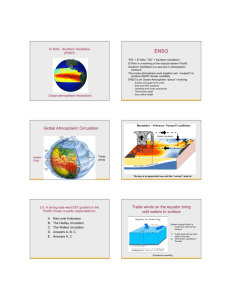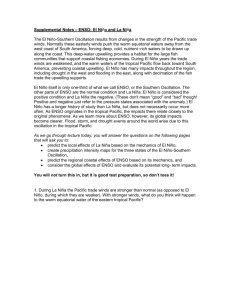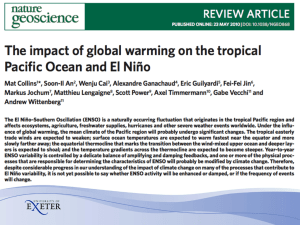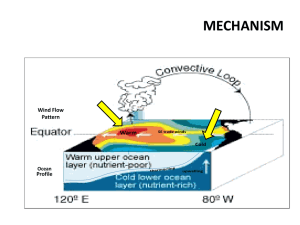ENSO.2100.part2
advertisement
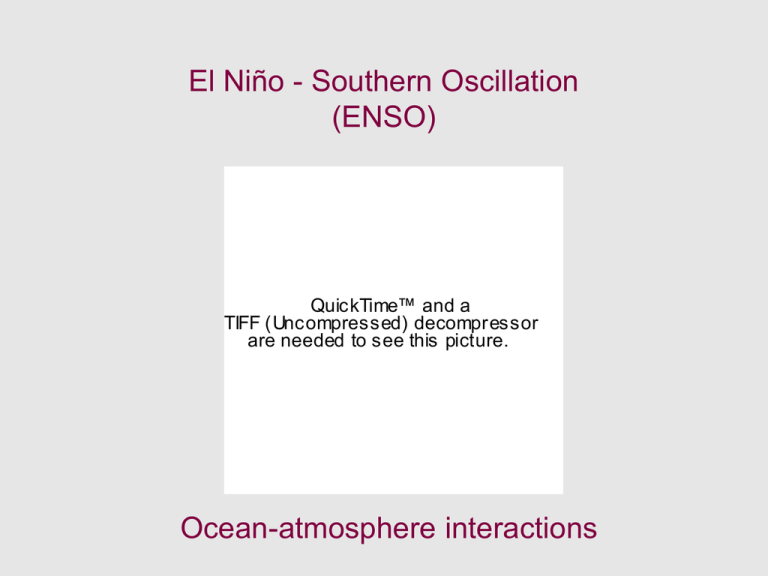
El Niño - Southern Oscillation (ENSO) QuickTime™ and a TIFF (Uncompressed) decompressor are needed to see this picture. Ocean-atmosphere interactions ENSO “EN” = El Niño; “SO” = Southern Oscillation El Niño is a warming of the tropical eastern Pacific Southern Oscillation is a see-saw in atmospheric pressure The ocean-atmosphere work together (are “coupled”) to produce ENSO climate variability ENSO is an Ocean-Atmosphere “dance” involving: - Surface and upper level winds East-west SST gradients Upwelling and ocean productivity Thermocline depth Sea surface height Global Atmospheric Circulation Hadley Cells QuickTime™ and a TIFF (Uncompressed) decompressor are needed to see this picture. Trade winds Walker circulation The key is to appreciate how odd the “normal” state is! Q1: A strong east-west SST gradient in the Pacific Ocean is partly responsible for: A. B. C. D. E. Rain over Indonesia The Hadley circulation The Walker circulation Answers A, B, C Answers A, C Trade winds on the equator bring cold waters to surface Eastern tropical Pacific is cooler than west for two reasons: QuickTime™ and a TIFF (Uncompressed) decompressor are needed to see this picture. 1) 2) Equatorial upwelling Trade winds pile up warm water in the west Wind-driven upwelling in the east Normal Conditions Note features: QuickTime™ and a TIFF (Uncompressed) decompressor are needed to see this picture. - East-west SST gradient - eastern upwelling - E-W Thermocline depth - E-W Sea surface height - Surface pressure - trade winds Hadley and Walker winds vary in phase: when Hadley cell is strong, so is the walker circulation Normal Conditions in the tropical Pacific QuickTime™ and a decompressor are needed to see this picture. Transition to El Niño QuickTime™ and a TIFF (Uncompressed) decompressor are needed to see this picture. Full El Niño conditions What are changes in QuickTime™ and a TIFF (Uncompressed) decompressor are needed to see this picture. - East-west SST - upwelling - Thermocline depth - Sea surface height - Surface pressure - trade winds - rainfall? El Niño Conditions What are changes in QuickTime™ and a decompressor are needed to see this picture. - East-west SST - upwelling - Thermocline depth - Sea surface height - Surface pressure - trade winds - rainfall? El Niño SST anomaly movie Anomalies Blue = cold Red = warm QuickTime™ and a mpeg4 decompressor are needed to see this picture. Largest El Niños of 20th century 1982 SST Anomaly (relative to the average state) 1997 La Niña Conditions What are changes in QuickTime™ and a decompressor are needed to see this picture. - East-west SST - upwelling - Thermocline depth - Sea surface height - Surface pressure - trade winds - rainfall? La Niña SST anomaly movie Anomalies Blue = cold Red = warm QuickTime™ and a mpeg4 decompressor are needed to see this picture. No two events alike… La Niña Cool SST warm SST Cold phase Warm Phase Walker Circulation Sir Gilbert Walker British mathematician, director general of observations for India (formed after monsoon failure of 1877- worst famine in Indian history) Arrived in 1904, shortly after huge famine caused by drought Goal to predict Indian Monsoon Found that many global climate variations, including Monsoon rains in India, were correlated with the Southern Oscillation Q2: Place in order of low to high surface atmospheric pressure Ocean temperatures Pink = warm green = cool C A. B. C. D. E. B A, B, C C, B, A B, C, A A, C, B Can’t tell A SOI = Tahiti SLP - Darwin SLP Tahiti Darwin Average Climatology: 1933-1992 Southern Oscillation Index • SOI is a “proxy” for El Nino - La Nina state • High SOI = Tahiti SLP > Darwin SLP = La Niña • SOI is the ATMOSPHERIC expression of ENSO. • The OCEANIC expression of ENSO: SSTs, upwelling, thermocline, SST height, ocean productivity + ∆SLP - * * nino3 Difference in Jan. SST between the two extreme ENSO episodes of this century ENSO: Physical coupling between the ocean and atmosphere Important Slide! Blue = Atm pressure at Darwin Red = SST anomaly for the NINO3 region Connecting El Niño and the SO (ENSO) The link between SO and El Niño was made convincingly by Bjerknes Made extensive use of data gathered during 1957 (strong El Niño year) Realized that unusual events separated by half the circumference of Earth could be linked together as parts of a huge coupled phenomenon ENSO– involving both the ocean and the atmosphere. Prof. Jacob Bjerknes General Description of ENSO Processes Bjerknes established the empirical connection between EN and SO. He also provided a hypothesis about the mechanism that underlies our present understanding. The key is to appreciate how odd the “normal” state is – The easterly trades drive westward currents, bringing the cold waters of the Peru Current from the South American coast – The coriolis force turns westward surface currents poleward, causing divergence and upwelling – The trade winds push the warm upper layer waters poleward as well as westward, pulling the thermocline to the surface in the east – All are due to the easterly winds, but the easterly winds are also due to temperature contrasts along the equator. Thus there are positive feedbacks to reinforce both El Niño and La Niña phases A very simplified view of ocean-atm coupling Why does ENSO State tend to Oscillate? Equatorial ocean dynamics Key observations by Klaus Wyrtki in 1970’s El Nino is preceded by a transfer of warm water from west to east This transfer is thought to trigger a warm event What triggers the movement of water? – In cold phase, waters cold (and low) in east, warm (and high) in west – Warm water from west sloshes back and overshoots equilibrium- positive feedbacks mentioned before set of El Niño conditions Why does ENSO State tend to Oscillate? Shortest Answer: Equatorial ocean dynamics Short answer: Differing timescales of Kelvin and Rossby Wave propagation Longer answer: The oscillation is made possible due to the asymmetry between eastward and westward oceanic motions (see 2-D Animation in notes). Along the equator there is a relatively fast eastward motion called an equatorial Kelvin wave. Peaking somewhat off the equator are westward motions called Rossby waves. Time scale: <1 yr for the Kelvin waves to shift the warm pool eastward [once trades relax]; 2 yrs for the Rossby waves to return the warm pool to the west, to await another wind relax. Kelvin Rossby Here is a 3-D animation the tropical Pacific as it cycles through an El Niño then La Niña event. The surface shown is sea-level (in cm) and the surface is colored according to the SST anomalies associated with each event. Prediction for Winter ‘08 “normal” Global SST anomalies - last week QuickTime™ and a decompressor are needed to see this picture. QuickTime™ and a TIFF (Uncompressed) decompressor are needed to see this picture. http://iridl.ldeo.columbia.edu ENSO and Global Warming Still no consensus Persistent El Niño? Persistent La Niña? Surface ocean warms uniformly. Warming penetrates to thermocline. Ocean-atm coupling sustains El Niño mode. Surface ocean warms differentially; West warms more. WEP SST warming drives convection there Strengthens Walker Cell. Ocean-atm coupling sustains La Niña mode. El Niño Forecasting QuickTime™ and a TIFF (Uncompressed) decompressor are needed to see t his picture. Stephen E. Zebiak Mark Cane Director General International Research Institute for Climate Prediction Chair, DEES Vetlesen Professor

